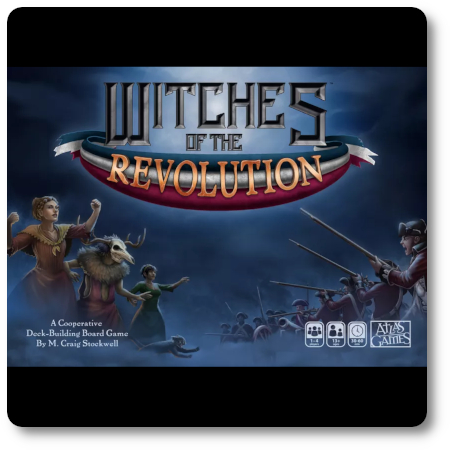 The Basics:
The Basics:
- For ages 13 and up
- For 1 to 4 players
- Approximately 60 minutes to complete
Geek Skills:
- Active Listening & Communication
- Counting & Math
- Logical & Critical Decision Making
- Reading
- Pattern/Color Matching
- Strategy & Tactics
- Risk vs. Reward
- Cooperative & Team Play
- Hand/Resource Management
Learning Curve:
- Child – Moderate
- Adult – Easy
Theme & Narrative:
- Join the revolution and win your country’s freedom through magic and subterfuge
Endorsements:
- Child Geek rejected!
- Parent Geek approved!
- Gamer Geek mixed!
Overview
People traveled to America for the promise of freedom from religious and political persecution. Of the many thousands who made the journey, hidden among them were witches, practitioners of magic, and guardians of secrets. In small villages and remote towns, their Covens grew. When the call to battle came, and every citizen of the new land was asked to take up arms against England and King George III, the witches and their Covens answered the call. The revolution began, and even witches played a part in the war to come from the shadows.
Witches of the Revolution, designed by M. Craig Stockwell and published by Atlas Games, is comprised of 120 cards, 80 mini cards (half the size of a standard playing card), 42 assorted cardboard tokens, and one game board. The cards are as thick and as durable as your standard playing card. The tokens and the game board are made of sturdy cardboard. The illustrations by James Mosingo and Alan Washburn work to benefit the game’s theme, adding color and depth to each card.
The Sparks of Revolution
To set up the game for two or more players, complete the following steps:
First, place the game board and the Moon Track and Liberty Track markers on their starting spaces.
Second, give to each player their starting Seeker cards, placing any unused starting cards back in the game box. These cards represent the player’s starting Coven. They should be shuffled and the deck placed face-down before their owning player, leaving room for individual discard piles. Each player then draws their starting hand of five cards from their deck. This personal card deck is called the player’s “Coven deck.”
Third, take the Recruit cards and set aside the “Blessing” Recruit cards. Shuffle the remaining Recruit cards, dealing one card facing up to each ” Recruit ” space on the game board. Then, roughly divide the remaining Recruit cards into three stacks. Shuffle the “Blessing” Recruit cards set aside and deal one face-down to each of the three Recruit stacks, placing any unused back in the game box. Then, shuffle each stack separately. Finally, place each stack back together to form one Recruit deck. Place the Recruit deck face-down on its game board space.
Fourth, randomly select one Objective card for each of the four types, placing it face-up on the game board. Any Objective cards not used are returned to the game box.
Fifth, place the exact number and type of Objective markers under the cards as noted on them.
Sixth, shuffle the Event cards together and place them face-down on the game board space to create the Event deck.
This completes the game’s setup. Determine who will be the first player, and let the revolution begin!
Hexes and Revolution
Witches of the Revolution is a cooperative game, meaning all the players work together to beat the game. They will either win or lose as a group. The game is played in turns. During a player’s turn, they complete a series of steps. Once the steps are completed, the next player takes their turn. A player’s turn is summarized here.
Step One: Add a Recruit
The active player draws and reveals the topmost card from the Recruit deck, placing it in the leftmost Recruit space and sliding all other face-up Recruit cards to the right to make room. Any Recruit card that is moved off the far right space is discarded.
There are three exceptions to this step.
- This step is skipped during the first turn as the Recruit spaces are already occupied
- This step is skipped if the Recruit deck is depleted (no more cards left to draw)
- If the drawn card is a “Blessing,” the instructions on the card are read out loud, resolved, and then the card is discarded
Step Two: Add an Event
The active player draws and reveals the top-most Event card from the Event deck, placing it in the first Event Line space on the game board. Similar to the Recruit draw and placement, any Event cards on the Event line are shifted to the right to make room for the new Event card as needed.
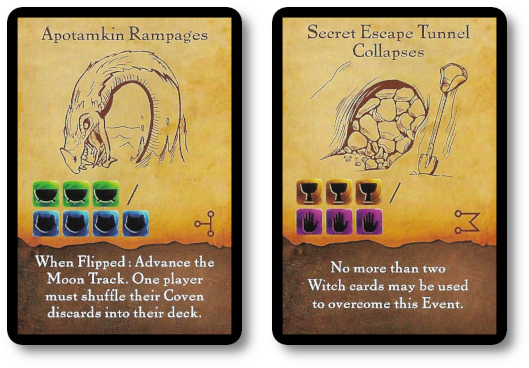
Caution should be taken before and after this step. The game can end badly for the players if the Event cards previously drawn are not properly managed, as they are a very real threat.
Some event cards automatically have an action that must be resolved when revealed. If such is the case, immediately resolve the action noted on the Event card, discarding any “banished” cards per the action resolution.
As the Event cards move on the Event Line on the game board, they shift position and trigger movement on the Liberty track. If such is the case, the Liberty Marker is adjusted accordingly one space towards Tyranny.
In addition, some Event cards can force the active player to discard a Recruit card face-up on the game board. The Recruit card banished is up to the active player, but because this is a cooperative game, they should feel free to discuss with their fellow players which card should be discarded.
Step Three: Act, Recruit, or Both
If the game has not ended, the active player may take one or both actions in any order. Note that some cards in the active player’s turn may allow them to take an additional Act or Recruit action.
Act
This action allows the active player to attempt to overcome an Event in the Event line. To overcome an Event, the active player plays several cards from their hand that display a total number of icons equal to the same number and type of icons on the Event card. If the Event card has two cost requirements, the active player only needs to pay the cost of one, not both.
The active player can play as many cards from their hand as they like. In addition, each non-active player can contribute and assist by giving the active player one card to use to overcome the Event. Each additional card provided by non-active players only contributes one icon of the type needed, regardless of the number shown. The one exception is if a “Relic” was provided as an assist. If such is the case, and due to the relic’s power, all of the icons shown are provided.
Cards played are returned to their owner’s discard pile. This includes any cards provided as an assist. “Relics” do not. Once used, these unique and powerful cards are removed for the game’s duration.
When an Event is overcome, the active player may remove any marker that matches any icon on that Event card. The active player keeps removed markers as “Trophies” that can be used to resolve Events in subsequent turns by using them to represent needed icons and reduce the cost of recruiting. In addition, if the Event has a “Liberty” icon, the active player adjusts the Liberty Track marker in the player’s favor.
Fun fact: paying double the cost is possible and provides benefits. If the cost paid is double the icons listed on the Event card, the active player collects two “Trophies” of any type they like, which are available from the Event card.
The Event card overcome is discarded when the Act action is fully resolved.
Recruit
The Recruit cards on the game board are potentially strong witches to aid in the revolution, but they are not yet members of the active player’s coven. To access these recruits, the player must pay for them. The star icons note the cost of each Recruit card and what they provide to pay the price (represented in pentagrams).
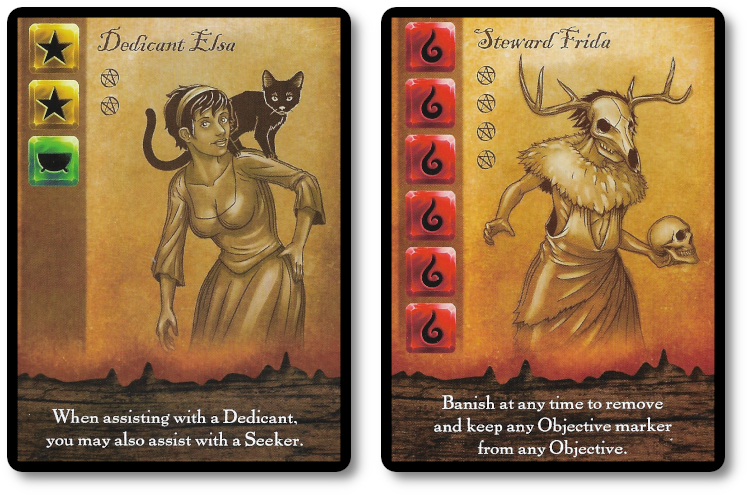
If the cost is paid in full, the Recruit card is taken from the game board and placed on top of the active player’s Coven deck, meaning it will be immediately available during the player’s next turn. However, any cards used to pay for the recruit are discarded to the Recruit deck discard pile, meaning they are no longer available to the active player.
The cost of Recruits will shift during the game. For example, depending on the Recruit card’s space on the game board, it could be less expensive. Similarly, depending on the location of the Liberty Track marker, Recruit cards could be more expensive. There are also some cards, such as Relics, that will not cost anything for the player to take.
The cost can also be reduced by spending Trophies. Any player can discard a Trophy to reduce the cost of recruiting a card when the Recruit action is being taken. This means the active and non-active players can spend Trophies simultaneously to reduce the cost. The cost is reduced by one star for every two Trophies spent.
Step Four: Discard
The active player may now discard any number of the cards in their hand if they like. A player is not forced to discard during this step.
Step Five: Draw
The active player may now draw as many cards as needed from their personal Coven deck to bring their hand up to their current hand-size limit (by default, five cards). A player is not forced to draw cards during this step, however. If the active player elects to draw cards, they must draw as many cards as needed to bring their hand to their full hand-size limit. It’s all or nothing.
It’s important to note why steps four and five are optional. Bad things happen whenever a player has no cards in their Coven deck when they need to draw them. After the player takes all their discarded Coven cards, shuffles them, and creates a new draw deck, the Moon Track marker advances one space in the wrong direction (making it challenging to overcome Events), and an Event card is added to the Event line.
Winning or Losing the Revolution
All the players win the game if they can achieve the Objective cards. This is done when all markers are removed from the Objective card. Once the objective is achieved, it’s resolved, and the players are awarded a minor boon. Once the boon’s reward is determined, the Objective card is flipped face-down on the game board.
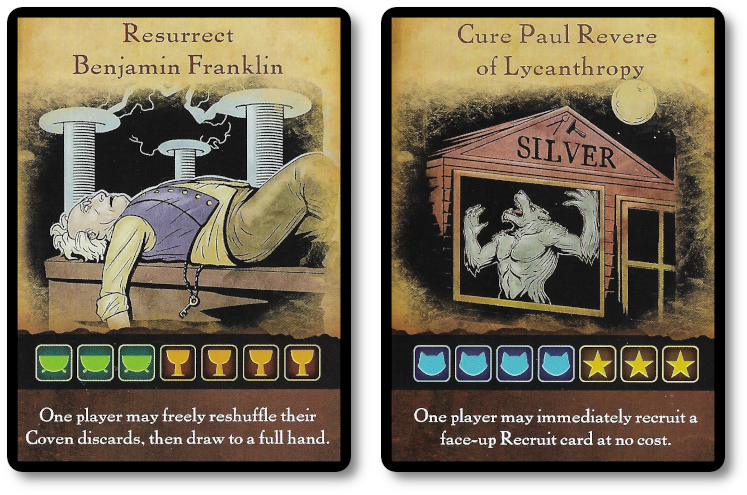
All the players lose if any of the following three conditions are met:
- The marker on the Liberty Track is moved fully over to Tyranny (say bye-bye to liberty and the American Way)
- An Event card is moved too far on the Event Line before it’s overcome
- The last Event card is drawn from the deck, and the players don’t complete all their Objectives by the end of the active player’s turn
Game Variants
The game can be played solo. The only change is the default hand-size limit, which increases from five to six (somewhat offsetting the lack of assistance you would typically get from other players during the game).
If the game is too hard, all six “Blessings” can be added to the Event deck, and one free reshuffle can be given to each player before it starts to reduce the Moon Track marker. The game can also be made easier for new players by removing Event cards that show a “blood splatter” image on their faces. These are no different than other event cards in any respect, except that they cost a lot to overcome. I suggest you keep them in.
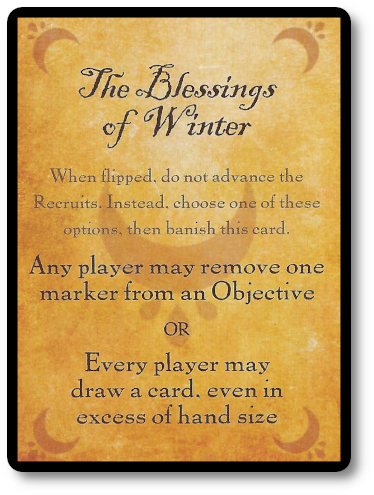
To learn more about Witches of the Revolution, visit the game’s webpage.
Final Word
 The Child Geeks learned how to play the game quickly, and the game board helped a great deal in organizing gameplay and cooperative teamwork. The game was punishing and didn’t let the Child Geeks have much in the way of wiggle room when learning how to work as a team. We quickly adopted the more accessible and easier gameplay, giving the Child Geeks the room to play the game without feeling bullied. According to one Child Geeks, “I liked the game’s story and how you worked together as a group to win. We never did, but I thought the game was ok.” Another Child Geek said, “I thought the game was hard even when everyone said it was on easy mode. I didn’t like the game because I never felt we had a chance to win.” When the last spell was cast, the Child Geeks took a vote and found that Witches of the Revolution did not bewitch them.
The Child Geeks learned how to play the game quickly, and the game board helped a great deal in organizing gameplay and cooperative teamwork. The game was punishing and didn’t let the Child Geeks have much in the way of wiggle room when learning how to work as a team. We quickly adopted the more accessible and easier gameplay, giving the Child Geeks the room to play the game without feeling bullied. According to one Child Geeks, “I liked the game’s story and how you worked together as a group to win. We never did, but I thought the game was ok.” Another Child Geek said, “I thought the game was hard even when everyone said it was on easy mode. I didn’t like the game because I never felt we had a chance to win.” When the last spell was cast, the Child Geeks took a vote and found that Witches of the Revolution did not bewitch them.
 The Parent Geeks found the game and gameplay engaging, challenging, and a good time. According to one Parent Geek, “I liked the game’s theme, and the cooperative deck-building types of games are some of my favorite. There is something delightful about playing a game with friends and family at a table and all working together to win!” Another Parent Geek said, “A great game for my friends and I, but it fell flat with my kids. I’m pretty sure it’s because the game was hard to win. Even though I didn’t win every game, I still felt like I had a great time. I’d play this again.” When the last of King George’s men were run out of town, the Parent Geeks took a vote and found that Witches of the Revolution was worthy of their praise.
The Parent Geeks found the game and gameplay engaging, challenging, and a good time. According to one Parent Geek, “I liked the game’s theme, and the cooperative deck-building types of games are some of my favorite. There is something delightful about playing a game with friends and family at a table and all working together to win!” Another Parent Geek said, “A great game for my friends and I, but it fell flat with my kids. I’m pretty sure it’s because the game was hard to win. Even though I didn’t win every game, I still felt like I had a great time. I’d play this again.” When the last of King George’s men were run out of town, the Parent Geeks took a vote and found that Witches of the Revolution was worthy of their praise.
 The Gamer Geeks had no problem learning how to play the game and jumped right in. They played slightly with the difficulty settings but always returned to the default as a quality standard. According to one Gamer Geek, “This is a good enough deck-building game that has a theme so pasted on that I can still smell the glue. But the game is well structured, I love the game board, and the game has just enough engagement to keep me interested. I’d say this is a light game that is a bit too difficult for what it is, but I was still charmed by it.” Another Gamer Geek said, “There are better cooperative deck-building games available. I thought this game was fun enough to try and play a few times, but I also believe it to be forgettable.” When the Liberty Bell made its final ring, the Gamer Geeks all agreed that Witches of the Revolution had a place at their table, but only barely.
The Gamer Geeks had no problem learning how to play the game and jumped right in. They played slightly with the difficulty settings but always returned to the default as a quality standard. According to one Gamer Geek, “This is a good enough deck-building game that has a theme so pasted on that I can still smell the glue. But the game is well structured, I love the game board, and the game has just enough engagement to keep me interested. I’d say this is a light game that is a bit too difficult for what it is, but I was still charmed by it.” Another Gamer Geek said, “There are better cooperative deck-building games available. I thought this game was fun enough to try and play a few times, but I also believe it to be forgettable.” When the Liberty Bell made its final ring, the Gamer Geeks all agreed that Witches of the Revolution had a place at their table, but only barely.
 Witches of the Revolution is a solid game with an intriguing theme, but the gameplay doesn’t deliver for anyone already well-experienced with cooperative deck-building games. The gameplay is – for lack of a better word – obvious. It’s evident when you should act or recruit. For those new to this type of game, there is a great deal of joy and fun to be had, as the game’s execution is always the same, allowing new and inexperienced players to get into a rhythm that pays off.
Witches of the Revolution is a solid game with an intriguing theme, but the gameplay doesn’t deliver for anyone already well-experienced with cooperative deck-building games. The gameplay is – for lack of a better word – obvious. It’s evident when you should act or recruit. For those new to this type of game, there is a great deal of joy and fun to be had, as the game’s execution is always the same, allowing new and inexperienced players to get into a rhythm that pays off.
Sadly, the game’s theme of renegade magic-users looking to help fight for freedom from the tyranny of another country is not as strong as I or any of our other players would have liked. This was a real bummer for the Child Geeks, who were hoping to play as witches and mages, fighting armies of England while they tried to save the young United States. Well, you do, but you have to put a lot of imagination into it, and the lightly coated theme does little to help.
And yet, I very much enjoyed this game. Despite the turns feeling formulaic at times, I didn’t once think I would win with ease. Right out of the box, the default difficulty was enough to make every player sweat. Victories were hard-won, and defeats were brutal. This game is easy to play and even easier to lose. You must keep your wits about you and keep talking as a team while playing or you will undoubtedly go down.
All in all, Witches of the Revolution was a solid deck-building game. It introduces some new ideas and gameplay concepts, which is always lovely, but the game never shined as brightly as I had hoped at the gaming table. True, everyone enjoyed the game’s theme, but the game itself never surpassed what should have been “great.” Even so, I’d play this game again without hesitation. Give it a shot at your gaming table to see if it’s revolutionary with you and yours.
This game was given to Father Geek as a review copy. Father Geek was not paid, bribed, wined, dined, or threatened in vain hopes of influencing this review. Such is the statuesque and legendary integrity of Father Geek.



